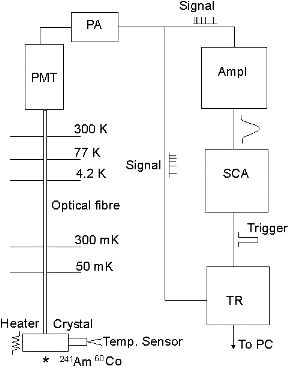
|
The Oxford EDELWEISS, LUX-ZEPLIN and g−2 group |

|
|
Home |
Members |
Publications |
Dark Matter |
Precision
Measurements
|
Research Activities
|
| |
|
|
|
|
|
Multiphoton coincidence technique and studies of scintillation properties over wide temperature range
The multiphoton counting technique (MPC) is a technique developed by
our group to measure the scintillation
parameters of samples over a wide temperature range [1, 2].
The MPC method works by recording a sequence of single photon pulses produced by a PMT
due to the photons from a scintillation event. Each pulse in the sequence
corresponds to an individual photon impinging on the photocathode of the
PMT. The distribution of arrival times of the photons provides
information on the decay characteristics of the scintillation process,
while the number of photons recorded per event is proportional to the
light yield of the scintillator. Thus, by recording a large number of
scintillation events (103 – 104) one can obtain
the decay time characteristics and the light output in a single
measurement.
A
schematic of this setup is shown to the right. The PMT signal is
passed to an integrating amplifier that produces a signal that is a
measure of the total energy detected; this is fed into a single channel
analyser (SCA). The discrimination thresholds of the SCA reduce the number of pulses with low and very high amplitudes
which are associated with electronic noise and spurious events caused by
cosmic muons, respectively. The logic output pulses of the SCA produce a
trigger for the transient recorder (TR).
|
 |
| Experimental setup for characterisation of
scintillation materials over 7-300 K temperature range in
He-flow cryostat |
|
All scintillation events recorded by the transient recorder are
acquired and analysed using custom-made DAQ software. A
key aspect of the MPC technique is that it can discriminate
between single and multiple events via statistical analysis of
the arrival times of individual scintillation photons. The
algorithm used for searching for and eliminating multiple events
is based on the idea that the decay time constant τ obtained
for each event should be noticeably dissimilar between single
events and multiple events. The statistical analysis consists of
a combination of a cut on the number of photons, a Shapiro-Wilk
likelihood cut and a Poisson statistics cut for the distribution
of arrival times of the photons.
Using MPC we
have investigated the temperature dependence of
scintillation light output and decay time of CaWO4
down to 20 mK [3]. The scintillation light yield was shown to be
independent of temperature below 10 K (fig. 2); as assumed
in many cryogenic scintillator experiments, but until this study
unproven. This finding provides a long-awaited support for the
assumption that data from studies above 10 K can be used to
assess the suitability of scintillation materials for applications
at much lower temperatures.
The decay
kinetic of CaWO4 and its temperature dependence was
analysed within the framework of a simple three-level model of
the emission centre with one metastable level. Subsequently the
formula that describes the temperature dependence of the decay
time constant τr was derived as
follows:

where k1 and k2 are
the probabilities of radiative decay from levels 1 and
2 separated by energy gap
D, K is
a the probability of non-radiative decay rate and ΔE
is
the energy barrier of the non-radiative quenching process.
This model
successfully describes the features of the decay kinetics,
giving the parameters of the relaxed excited state of the
emission centre (see Fig. 3).
|
|
|
References
Multiple photon
counting coincidence (MPCC) technique for scintillator characterisation
and its application to studies of CaWO4 and ZnWO4
scintillators, H. Kraus et al. Instr. Meth. A 553 (2005) 522
– 534.
Multiple photon counting technique for detection and
analysis of slow scintillation processes, H
Kraus et al. Radiation Measurements 42 (2007) 921.
Scintillation
studies of CaWO4 in the milli-kelvin temperature range,
V. B. Mikhailik et al. Phys. Rev. B 75 (2007) 184308.
|
|
| Site © 2011, The University of Oxford Physics Department. Comments about this website: email webmaster@physics.ox.ac.uk. |
| |
physics, oxford, university, the university of oxford, conference, conferencing, admissions, undergraduates, jobs, astrophysics, condensed, matter, atmospheric, laser, atomic, particle, theory, theoretical, ocean, planet
|
|





